NCERT Exemplar Solutions for Class 12 Biology chapter 5 Principles of Inheritance and Variation
These Solutions are part of NCERT Exemplar Solutions for Class 12 Biology. Here we have given NCERT Exemplar Solutions for Class 12 Biology chapter 5 Principles of Inheritance and Variation
Multiple Choice Questions
Question 1.
All genes located on the same chromosome
(a) form different groups depending upon their relative distance
(b) form one linkage group
(c) will not from any linkage groups
(d) form interactive groups that affect the phenotype.
Answer:
(b) : Linked genes are the genes which occur on the same chromosome. ,A linkage group is a physical association of linked genes which are normally inherited together except for crossing over.
Question 2.
Conditions of a karyotype 2n ± 1 and 2n ± 2 are called
(a) aneuploidy
(b) polyploidy
(c) allopolyploidy
(d) monosomy.
Answer:
(a) : The chromosomal disorders are caused due to absence or excess or abnormal arrangement of one or more chromosomes. Failure of segregation of chromatids during cell division cycle results in the gain or loss of chromosome(s), is called aneuploidy. For example, Down’s syndrome results due to gain of extra copy of chromosome 21. Similarly, Turner’s syndrome results due to loss of an X chromosome in human females.
Question 3.
Distance between the genes and percentage of recombination shows
(a) a direct relationship
(b) an inverse relationship
(c) a parallel relationship
(d) no relationship.
Answer:
(a) : Linkage is the phenomenon of physical association of genes on a chromosome and recombination is the generation of non- parental gene combinations. Strength of the linkage between two genes is inversely proportional to the distance between the two, i.e., two linked genes show higher frequency of crossing over (recombination) if the distance between them is higher and lower frequency if the distance is small. But distance between gene has a direct relationship with percentage of recombination because with increase in distance between genes, percentage of recombination increases.
Question 4.
If a genetic disease is transferred from a phenotypically normal but carrier female to only some of the male progeny, the disease is
(a) autosomal dominant
(b) autosomal recessive
(c) sex-linked dominant
(d) sex-linked recessive.
Answer:
(d) : The sex linked recessive disease shows its transmission from unaffected carrier female to some of the male progeny e.g., haemophilia. The heterozyous female (carrier) of haemophilia may transmit the disease to sons. The possibility of a female becoming a haemophilic is extremely rare because mother of such a female has to be at least carrier and the father should be haemophilic.
Question 5.
In sickle cell anaemia glutamic acid is replaced by valine. Which one of the following triplets codes for valine?
(a) GGG
(b) A AG
(c) GAA
(d) GUG
Answer:
(d) :The sickle-cell anaemia is caused by the substitution of glutamic acid (Glu) by valine (Val) at the sixth position of the beta globin chain of the haemoglobin molecule. The substitution of amino acid in the globin protein results due to the single base substitution at the sixth codon of the beta globin gene from GAG to GUG. The mutant haemoglobin molecule undergoes polymerisation under low oxygen tension causing the change in the shape of the RBC from biconcave disc to elongated sickle like structure.
Question 6.
Person having genotype /A /B would show the blood group as AB.This is because of
(a) pleiotropy
(b) codominance
(c) segregation
(d) incomplete dominance.
Answer:
(b) : ABO blood groups are controlled by the gene I. The plasma membrane of the red blood cells has sugar polymers that protrude from its surface and the kind of sugar is controlled by the gene. The gene (I) has three alleles IA, IB and i. The alleles IA and /B produce a slightly different form of the sugar while allele i does not produce any sugar. Because humans are diploid organisms, each person possesses any
two of the three I gene alleles. IA and /B are completely dominant over /, in other words when IA and i are present then only IA expresses (because i does not produce any sugar), and when /B and i are present IB expresses. But when IA and /B are present together they both express their own types of sugars, this is because of codominance. Hence, in this case red blood cells have both A and B types of sugars.
Question 7.
ZZ/ZW type of sex determination is seen in
(a) platypus
(b) snails
(c) cockroach
(d) peacock.
Answer:
(d) : In birds and some reptiles both the sexes possess two sex chromosomes but unlike human beings the females contain heteromorphic sex chromosomes (AA + ZW) while the males have homomorphic sex chromosomes (AA + ZZ). Because of having heteromorphic sex chromosomes, the females are heterogametic (female heterogamety) and produce two types of eggs, (A + Z) and (A + W). The male gametes or sperms are of the one type (A + Z). 1:1 sex ratio is produced in the offspring.\
Question 8.
A cross between two tall plants resulted in offspring having few dwarf plants. What would be the genotypes of both the parents?
(a) TTandTt
(b) TtandTt
(c) TT andTT
(d) Tt and tt
Answer:
(b) : The genotypes of both the parents are :
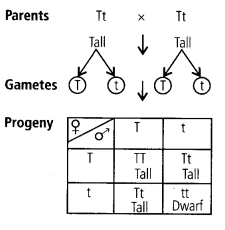
Question 9.
In a dihybrid cross, if you get 9:3 :3 :1 ratio it denotes that
(a) the alleles of two genes are interacting with each other
(b) it is a multigenic inheritance
(c) it is a case of multiple allelism
(d) the alleles of two genes are segregating independently.
Answer:
(d) : Cross involving two contrasting characters is called dihybrid cross or a two factor cross. The two factors of each trait assort at random and independent of the factors of other traits at the time of meiosis (gametogenesis) and get randomly as well as independently rearranged in the offspring producing both parental and new combinations of traits. This explained the law of independent assortment given by Mendel.
Question 10.
Which of the following will not result in variations among siblings?
(a) Independent assortment of genes
(b) Crossing over
(c) Linkage
(d) Mutation
Answer:
(c) : Linkage will not result in variations among siblings because linked genes occur on the same chromosome and are transmitted together. In linkage there is a tendency to maintain the parental gene combinations except for occasional crossovers.
Question 11.
Mendel’s law of independent assortment holds good for genes situated on the
(a) non-homologous chromosomes
(b) homologous chromosomes
(c) extra nuclear genetic element
(d) same chromosome.
Answer:
(b) : According to the Mendel’s law of independent assortment, the pairs of “factors” segregate independently of each other when germ cells are formed. Homologous chromosomes synapse during meiosis and then separate to segregate independently into different cells which establishes the quantitative basis for segregation and independent assortment of hereditary factors.
Question 12.
Occasionally, a single gene may express more than one effect. The phenomenon is called
(a) multiple allelism
(b) mosaicism
(c) pleiotropy
(d) polygeny
Answer:
(c) : Pleiotropic allele has more than one effect in an organism. For example, the allele that causes the erythrocytes to have a distorted form in sickle-cell anemia also causes these blood cell to rupture easily.
Question 13.
In a certain taxon of insects some have 17 chromosomes and the others have 18 chromosomes. The 17 and 18 chromosomebearing organisms are
(a) males and females, respectively
(b) females and males, respectively
(c) all males
(d) all females.
Answer:
(a) : In certain insects XX – XO type of sex determination is observed where females have autosomes + i pair of sex chromosomes while males have autosomes + 1 sex chromosome.
Question 14.
The inheritance pattern of a gene over generations among humans is studied by the pedigree analysis. Character studied in the pedigree analysis is equivalent to
(a) quantitative trait
(b) Mendelian trait
(c) polygenic trait
(d) maternal trait
Answer:
(b) : Pedigree analysis is study of pedigree for the transmission of particular trait and finding the possibility of absence or presence of that trait in homozygous or heterozygous state in a particular individual. It indicates that Mendel’s principles are also applicable to human genetics with some modifications like quantitative inheritance, sex linked characters and other linkages.
Question 15.
It is said that Mendel proposed that the factor controlling any character is discrete and independent. His proposition was based on the
(a) results of F3 generation of a cross
(b) observations that the offspring of a cross made between the plants having two contrasting characters shows only one character without any blending
(c) self pollination of F1 offsprings
(d) cross pollination of F! generation with recessive parent.
Answer:
(b) : When plants having two contrasting characters are crossed, F, generation shows dominant phenotype and the recessive phenotype is not lost but appears in F2 generation. This suggested that there is no blending of Mendelian factors in Fj generation but they stay together and only one of them is expressed. At the time of formation of gametes, these two factors obviously separate or segregate, otherwise recessive type will not appear in F2 generation. The gametes which are formed are always pure for a particular character. That is why it is called as ‘principle of segregation’ or Taw of purity of gametes’.
Question 16.
In the F2 generation of a Mendelian dihybrid cross the number of phenotypes and genotypes are
(a) phenotypes-4;genotypes-16
(b) phenotypes-9; genotypes-4
(c) phenotypes-4; genotypes-8
(d) phenotypes-4; genotypes-9.
Answer:
(d) : Mendel performed crosses involving two characters called as dihybrid cross. Results of the dihybrid cross where the two parents different in two pairs of contrasting traits i.e. seed colour and seed
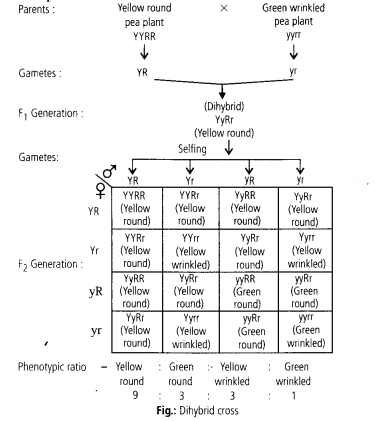

Question 17.
Mother and father of a person with ‘O’ blood group have’A’and’B’blood group respectively. What would be the genotype of both mother and father?
(a) Mother is homozygous for ‘A’ blood group and father is heterozygous for’B’.
(b) Mother is heterozygous for’A’blood group and father is homozygous for’B’.
(c) Both mother and father are heterozygous for’A’and’B’blood group, respectively.
(d) Both mother and father are homozygous for ‘A’ and ‘B’ blood group, respectively.
Answer:
(c) : If mother and father of a person with ‘O’ blood group have ‘A’ and ‘B’ blood group then both mother and father will be heterozygous for ‘A’ and ‘B’ blood group respectively.
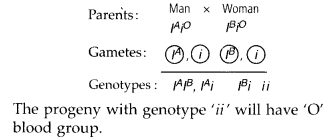
Very Short Answer Type Questions
Question 1.
What is the cross between the progeny of F, and the homozygous recessive parent called? How is it useful?
Answer:
The cross between the progeny of F, and the homozygous recessive plant is known as test cross.-This tells about unknown genotype, i.e., homozygous or heterozygous dominant nature of genotype.
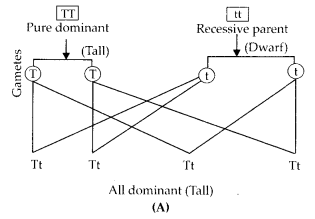
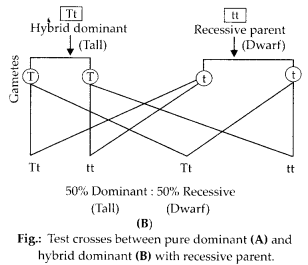
Question 2.
Do you think Mendel’s laws of inheritance would have been different if the characters that he chose were located on the same chromosome?
Answer:
Mendel’s laws of dominance and segregation would have remained the same. Mendel’s law of independent assortment would have been different if the characters that he chose were located on the same chromosome. If the characters are present on the same chromosome they would not assort independently and show linkage.”
Question 3.
Enlist the steps of controlled cross pollination. Would emasculation be needed in a cucurbit plant? Give reasons for your answer.
Answer:
Steps of controlled cross pollination are:
- Selection of parent
- Selfing
- Emasculation
- Bagging
- Tagging
- Artificial pollination
- Seed setting and harvesting.
Cucurbit plants are generally unisexual plants. So, emasculation cannot be needed. Emasculation is done in bisexual plants to prevent self pollination.
Question 4.
A person has to perform crosses for the purpose of studying inheritance of a few traits/ characters. What should be the criteria for selecting the organisms?
Answer:
The criteria for selecting the organism to study inheritance of characters are as follows:
- It should be easily available.
- Shorter life span.
- Breeding should be cheap and can be done throughout the year.
- A large number of progeny can be produced.
- Easily identifiable contrasting characters.
Question 5.
The pedigree chart given below shows a particular trait which is absent in parents but present in the next generation irrespective of sexes. Draw your conclusion on the basis of the pedigree.
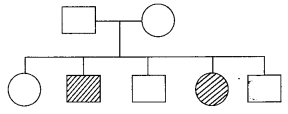
Answer:
Given pedigree chart shows autosomal recessive trait. Both parents of generation I are heterozygous (i.e., HbA Hbs) and carrier for the gene. The second and fourth child developed the trait so the genotype is homozygous recessive (i.e., Hbs Hbs). The first, third and fifth are carrier for the gene and genotype is heterozygous (i.e., HbAHbs).
Question 6.
In order to obtain the F, generation Mendel pollinated a pure breeding tall plant with a pure breeding dwarf plant. But for getting the F2 generation, he simply self-pollinated the tall Ft Why?
Answer:
Mendel cross pollinated plants of two different traits of the character of height in order to study their mixing in F1, generation. Only one trait appeared in F1 plants. For knowing the fate of other trait, he allowed the F1 plants to self-pollinate. F2 generation showed both the traits indicating the recessive trait of the dwarfness remains in F1 generation, but without expresison.
Question 7.
“Genes contain the information that is required to express a particular trait.” Explain.
Answer:
Gene is a unit of inheritance which consists of linear chromosome situated at a specific locus, and carries coded information associated with particular trait. The process of gene expression involves central dogma of genetics e.g., transcription and translation.
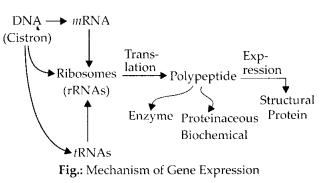
Question 8.
How are alleles of particular gene differ from each other? Explain its significance.
Answer:
Allele has a unique nucleotide sequence, it is one of the alternative forms of a gene. In a diploid cell there are usually two alleles of any one gene which occupy the same relative position on homologous chromosomes. These allele may be similar or one allele may be dominant to the other (known as the recessive). It controls the expression of a character.
Question 9.
In a monohybrid cross of plants with red and white flowered plants, Mendel got only red flowered plants. On self-pollinating these F, plants got both red and white flowered plants in 3 : 1 ratio. Explain the basis of using RR and rr symbols to represent the genotype of plants of parental generation.
Answer:
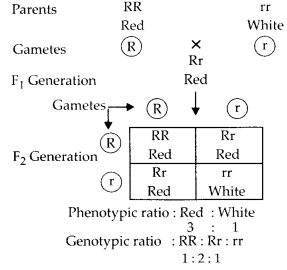
‘R’ represent the dominant character gene whereas V represent the recessive character gene. In F, plants (Rr) both the factors for red and white colour are present. However, the factors for white colour is unable to express itself in the presence of red colour. Hence, the factor for red colour is dominant over the factor for white colour. The factor for white colour is recessive.
Question 10.
For the expression of traits genes provide only the potentiality and the environment provides the opportunity. Comment on the veracity of the statement.
Answer:
The observable characteristics of an organism are determined by its genes, the relationships between the alleles and by the interaction of genes with the environment. Phenotype = Genotype + Environment (Trait) (Potentiality) (Opportunity) Genes can provide only the potentiality and the environment provides the opportunity for the expression of traits. For example a genetically tall plant can become tall only if it receives proper amount of sunlight, minerals and water.
Question 11.
A, B, D are three independently assorting genes with their recessive alleles a, b, d respectively. A cross was made between individuals of Aa bb DD genotype with aa bb dd. Find out the type of genotypes of the offspring produced.
Answer:
The cross between AabbDD and aabbdd and the type of offsprings produced would be:

So, genotypes of offspring produced will be AAbbDd and aabbDd.
Question 12.
In our society a woman is often blamed for not bearing male child. Do you think it is right? Justify.
Answer:
In humans, sex of the child is determined at the time of fertilisation. The female parent produces only one type of egg with X-chromosome. The male gametes are of two types with X-chromosome and Y-chromosome. Fertilisation of the egg with sperm carrying X-chromosome produces a female child while fertilisation with sperm carrying Y-chromosome give rise to male child. Thus sex of the child is determined by male (father) and not by the female (mother).
Question 13.
Discuss the geneticbasisof wrinkled phenotype of pea seed.
Answer:
Seed shape is determined by a single gene, with the allele (R) for round peas domipant over the allele (r) for wrinkled peas (recessive trait). If the alleles for the gene controlling the seed shape are homozygous in a plant, it will show the character or phenotype of the same alleles i.e., RR-Round seed, rr-wrinkled seed. On the other hand, if the alleles of gene are heterozygous, they will express the phenotype of dominant allele. Rr – Round seed (r-wrinkled is recessive). This is the genetic basis of wrinkled phenotype of pea seed.
Question 14.
Even if a character shows multiple allelism, an individual will only have two alleles for that character. Why?
Answer:
Despite multiple allelism, an individual will have only two alleles because an individual develops from a zygote which is the result of fusion of sperm (carrying father set of (n) haploid chromosomes) and an egg (carrying mother set of haploid chromosomes). Sperm and an egg have only one gene (allele) for each trait. Hence an individual will have two alleles despite the occurrence of several alleles in the population.
Question 15.
How does a mutagen induce mutation? Explain with example.
Answer:
Mutagen is an agent that causes an increase in the number of mutants in a population. There are basically two types of mutagens – physical mutagens like UV-rays, gamma rays and chemical mutagens like hydroxyl radicals. Mutagens operate either by causing changes in the DNA of the genes, so interfering with the coding system, or by causing chromosome damage. A mutagen can induce mutation by inducing a change in the base sequence by insertion, deletion or substitution.
Short Answer Type Questions
Question 1.
In a Mendelian monohybrid cross, the F2 generation shows identical genotypic and phenotypic ratios. What does it tell us about the nature of alleles involved? Justify your answer.
Answer:
In Mirabilis jalapa (Four o’clock) and Antirrhinum majus (Snapdragon or dog flower), there are two types of flower colour in pure state.When the two types of plants are crossed, the hybrid or plants of F1 generation have pink flowers, lithe latter are selfed, the plants of F2 generation are of three types—red, pink and white flowered in the ratio of 1 : 2 : 1 both phenotypically and genotypically. The pink colour apparently appears either due to mixing of red and white colours (incomplete dom inance) oi expression of a single gene for pigmented flower which produces only pink colour (quantitative inheritance).
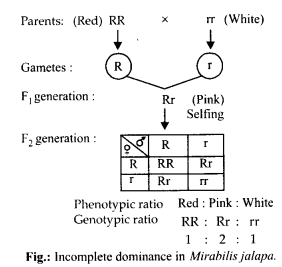
Question 2.
Can a child have blood group O if his parents have blood group ‘A’ and ‘B’. Explain.
Answer:
A child can have blood group O, if both the parents are heterozygous for their blood groups
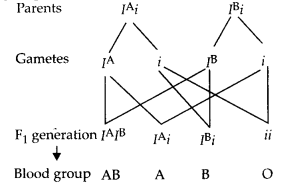
Question 3.
What is Down’s syndrome? Give its symptoms and cause. Why is it that the chances of having a child with Down’s syndrome increases if the age of the mother exceeds forty years?
Answer:
Down’s syndrome is a congenital form of mental retardation due to a chromosome defect in which there are three copies of chromosome no. 21 instead of the usual two (i.e., trisomy). The affected individual has a short broad face and slanted eyes (as in the Mongolian races), short fingers, and weak muscles. Down’s syndrome is caused when the chromosomes of the pair 21 pass into a single egg due to nondisjunction during oogenesis. Then, the egg possesses 24 chromosomes, instead of 23 and offspring has 47 chromosomes instead of 46. The frequency of Down’s syndrome increases, if the age of the mother exceeds forty years. It is due to factors that adversely affect meiotic chromosome behaviour with advancement of women age. In human females, meiosis starts in the foetus to produce egg cells, but it is not completed until after the egg is fertilised. During the long time prior to fertilisation, egg cells are arrested in prophase I. In this suspended state, chromosome may become unpaired. The longer the time in prophase I, the greater the chances for unpairing and chromosome nondisjunction.
Question 4.
How was it concluded that genes are located on chromosomes?
Answer:
The chromosomal theory of inheritance states that the Mendelian factors or genes are located at specific loci on the chromosomes. Occurence of genes over chromosomes was proved by Morgan (1910) during study of sex- linked inheritance of eye colour in Drosophila. It shows criss-cross inheritance, in which female fly passes its X-chromosome and eye colour to male offspring and male fly passes its X-chromosome and eye colour to female offspring.
Question 5.
A plant with red flowers was crossed with another plant with yellow flowers. If F, showed all flowers orange in colour, explain the inheritance.
Answer:
It is the phenomenon of neither of the two alleles being dominant so that expression in the hybrid is intermediate between the expressions of the two alleles in homozygous state. It is called incomplete dominance or intermediate inheritance. There are two types of flower colour in pure state: red and yellow. When the two types of plants are crossed, the hybrid or plants of F, generation have orange flowers. If the latter are selfed, the plants of F2 generation are of three types – red, orange and yellow flowered in the ratio of 1 : 2 : 1. The orange colour apparently appears due to mixing of red and yellow colours (incomplete dominance).
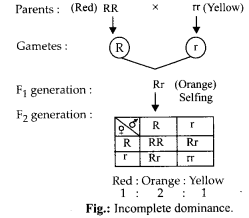
Question 6.
What are the characteristic features of a true- breeding line?
Answer:
A true breeding line is a pure line that shows same traits, generation after generation due to presence of homozygous characters. They are produced by repeated self fertilisation or breeding between identical homozygous ancestors. They are not superior to high yielding varieties, but are maintained for cross breeding and formation of new varieties.
Question 7.
In peas, tallness is dominant over dwarfness, and red colour of flowers is dominant over the white colour. When a tall plant bearing red flowers was pollinated with a dwarf plant bearing white flowers, the different phenotypic groups were obtained in the progeny in numbers mentioned against them.
Tall, red = 138
Tall, white = 132
Dwarf, red = 136
Dwarf, white = 128
Mention the genotypes of the two parents and of the four offspring types.
Answer:
The result shows four types of offspring with almost similar in number with ratio 1 : 1 : 1 : 1. This kind of result is possible in case of dihybrid test cross. One parent is double hybrid (TtRr) and the other one is double recessive (ttrr).
The test cross can be shown as :
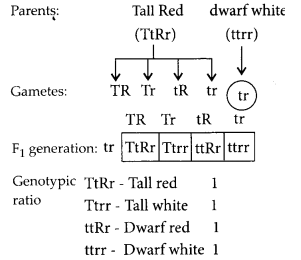
Question 8.
Why is the frequency of red-green colour blindness is many times higher in males than that in the females?
Answer:
Red and green colour blindness is due to X-linked recessive alleles. Males have XY sex chromosomes and presence of single recessive allele expresses itself. Females have XX sex chromosomes. The possibility of female being colour blind is very less because in females both X chromosome should carry the recessive trait, which is very rare due to large scale heterozygosity in human population.
Question 9.
If a father and son are both defective in red- green colour vision, is it likely that the son inherited the trait from his father? Comment.
Answer:
Red and green colour blindness is X-linked character. Colour blindness like any sex-linked trait, shows criss-cross inheritance, i.e., mother transfers traits to her granddaughter through their son, while the father passes traits to her grandson through his daughter. Males have XY type of sex chromosomes, and they get X chromosome from their mother. In this case it is possible that the mother of that male (son) must be a carrier for the character but not affected. Male to male inheritance of X-linked character is not possible.
Question 10.
Discuss why Drosophila has been used extensively for genetical studies.
Answer:
Drosophila is used extensively for genetical studies because of following advantages:
- It is easily available hovering over ripe mango/banana fruits where it feeds over yeast cells present over the fruit surface.
- The flies can be reared inside bottles having yeast culture over medium : containing cream of wheat, molasses and agar.
- A new generation can be raised within 2 weeks with single mating producing hundreds of individuals.
- The animals can be temporarily inactivated with ether and examined by hand lens/dissection microscope.
- Female is distinguishable from male by its larger size and ovipositor at the rear end.
- The animals possess four pairs of chromosomes of different sizes. The male fly possesses XY sex chromosomes while the female has XX chromosomes. Y chromosome is hooked and easily distinguished.
- Polytene chromosomes occur in salivary glands of larva which can indicate any type of abnormality.
- Breeding Drosophila is quite cheap. Further, it can be done throughout the year.
Question 11.
How do genes and chromosomes share similarity from the point of view of genetical studies?
Answer:
Similarities of behaviour of chromo-somes with Mendel’s factors / genes.
- Both pass from generation to generation in altered form.
- Both are present singly in gametes.
- An organism receives two genes and two chromosomes of each type from its two parents.
- Both follows mendelian principles.
- Each gene and each chromosome replicates during S-phase of cell cycle.
Question 12.
What is recombination? Discuss the applications of recombination from the point of view of genetic engineering?
Answer:
Recombination is the rearrangement of genes that occurs when reproductive cells (gametes) are formed. It results from the I independent assortment of parental sets of chromosomes and exchange of chromosomal material that occur during meiosis. Useful recombinations produced by crossing over are picked up by breeders to produce useful new varieties of crop plants and animals. Green revolution has been achieved in India due to this selective picking up of useful recombinations operation flood or white revolution is also being carried out on the similar lines. In genetic engineering, the desired genes can be taken from one source and introduce them in the cells of another organism in order to improve and change the same.
Question 13.
What is artificial selection? Do you think it affects the process of natural selection? How?
Answer:
Artificial selection is the modification of species by selective breeding. Animals or plants with desirable characteristics are interbred with the aim of altering the genotype and producing a new strain of the organism for a specific purpose. For example, sheep are bred by means of artificial selection in order to improve wool quality.Yes, it affects the process of natural selection. Natural selection selects trait based on their effect on the fitness of the organism. In artificial selection traits are selected based on human preference for improving traits.The process of natural selection leads to evolutionary change in the expression of the trait in the populations whereas the artificial selection being same process involves the traits preferred by humans for its own benefit. It is much faster than the natural selection, and it impose threat on diversity in long run making it unfit to the natural selected organism.
Question 14.
With the help of an example differentiate between incomplete dominance and codominance.
Answer:
Differences between incomplete dominance and codominance are as follows:
| Incomplete dominance | Codominance |
| (1) Effect of one of the two alleles is more conspicuous | The effect of both the alleles is equally conspicuous. |
| (2) It produces a fine mixture of the expression of two alleles. | There is no mixing of the effect of the two alleles |
| (3) The effect in hybrid is intermediate of the expression of the two alleles, e.g., flower colour in Mirabilis jalapa Red, Pink, and White | Both the alleles produce their effect independently, e.g., AB blood group. |
| (4) Alleles show quantitative effect. One dominant allele produces half and two dominant alleles produce full phenotype | There is no quantitative effect of the alleles. |
Question 15.
It is said, that the harmful alleles get eliminated from population over a period of time, yet sickle cell anaemia is persisting in human population. Why?
Answer:
Harmful alleles become lethal, whenever they occur in homozygous state. The affected individual does not transfer them to the next generation. Over a period of time, these alleles get eliminated from the population. This is not so in the case of sickle cell anaemia. Sickle cell anaemia is an autosomal recessive disorder in which the erythrocytes become sickle shaped under oxygen deficiency as during strenuous exercise and at high altitude.
Despite having harmful effect, the allele for sickle cell anaemia continues to persist in «human population because it has survival value in malaria infested areas like tropical Africa. Malarial parasite is unable to penetrate the erythrocyte membrane and cause any harm. Further, the sickle cell heterozygotes do not always suffer from syndrome. Their erythrocytes appear normal till there is oxygen deficiency when some sickle-shaped erythrocytes may be observed.
Long Answer Type Questions
Question 1.
In a plant tallness is dominant over dwarfness and red flower is dominant over white. Starting with the parents work out a dihybrid cross.What is’standard dihybrid ratio? Do you think the values would deviate if the two genes in question are interacting with each other?
Answer:
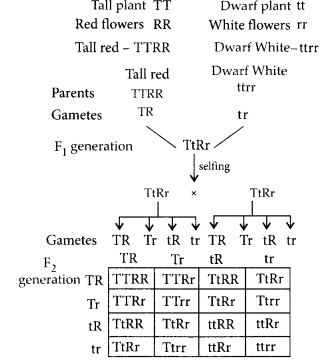
Tall red = 9
Tall white = 3 Phenotypic ratio = 9 : 3 : 3 : 1 dwarf red = 3 dwarf white = 1
This is a standard dihybrid phenotypic ratio. Alleles of two or more independent genes interact to produce a phenotypic expression different from the normal expression. They show7 dominant epistasis (12 : 3 : 1), recessive epistasis (9:3:4), dominant recessive epistasis (13 : 3) etc.
Question 2.
(a) In humans, males are heterogametic and females are homogametic. Explain. Are there any examples where males are homogametic and females heterogametic?
(b) Also describe as to, who determines the sex of an unborn child? Mention whether temperature has a role in sex determination.
Answer:
(a) Human males are said to be heterogametic because they produce two types of gametes as they have two different sex chromosomes X and Y in addition to autosomes e.g. (A + X) and (A + Y) type of gametes. Whereas human females are homogametic because they produce only one type of gametes, as they have XX sex chromosomes in addition to autosomes (A + X), (A+X). In birds females are heterogametic and have ZW sex chromosomes and males are homogametic with ZZ sex chromosomes.
(b) Sex of unborn child in human is determined by male. Males produce two types of gametes (A + X) and (A + Y). Females produce only one type of gametes (A + X). If (A + X) x (A + X) – female child If (A + X) x (A + Y) – male child Therefore sex of the unborn child completely depends on males. In crocodile and some lizards temperature has a role in sex determination, high temperature induces maleness and low temperature induces femaleness.
Question 3.
A normal visioned woman, whose father is colourblind, marries a normal visioned man. What would be the probability of her sons and daughters to be colour blind? Explain with the help of a pedigree chart.
Answer:
Colour blindness is a recessive sex- linked trait in which eye fails to distinguish red and green colours. The gene for normal vision is dominant. The normal gene and its recessive allele are carried by X-chromosomes. In females, colour blindness appears only when both the sex chromosomes, carry the recessive gene (XCXC). The females have normal vision but function as carrier if a single recessive gene for colour blindness is present (XXC). In males, the defect appears in the presence of a single recessive gene (XCY) because Y-chromosome of male does not carry any gene for colour vision.Flere, woman is normal visioned, whose father is colour blind, so woman act as carrier because she has got one gene for colour blindness from her father. She marries a normal man, then her 50% daughters will be carrier and 50% will be completely normal. Her 50% sons will be colour blind and 50% will be normal.
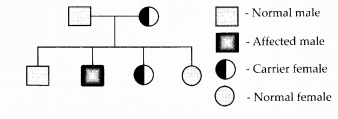
Question 4.
Discuss in detail the contributions of Morgan and Sturtevant in the area of genetics.
Answer:
Morgan carried out many dihybrid crosses in Drosophila to study the genes which were sex linked. He hybridised yellow bodied white eyed female to brown bodied red eyed males and intercrossed their F[ progeny. He observed that two genes did not segregate independently and deviated normal F,
ratio 9 : 3 : 3 : 1.
According to him if two genes in a dihybrid cross are situated on same chromosome, the parental gene combinations are much higher than non-parental ones. He gave the term linkage to physical association of genes and recombination to non-parental characters.His students Alfred Sturtevant used the frequency of recombination between gene pairs on the same chromosomes as a measure of distance between genes and mapped their position on the chromosome. The first chromosome maps were prepared by Sturtevant in 1911 for two chromosomes in Drosophila. Genetic maps are extensively used these days as a starting point in sequencing of whole genome in Human Genome Project (HGP).
Question 5.
Define aneuploidy. How is it different from polyploidy? Describe the individuals having following chromosomal abnormalities.
(a) Trisomy of 21st chromosome
(b) XXY
(c) XO
Answer:
Aneuploidy is the phenomenon of gain or loss of one or more chromosomes that results due to failure of separation of the members of the homologous pairs of chromosomes during meiosis. Polyploidy is a increase of entire set of chromosomes whereas aneuploidy is the addition or deletion of one or few chromosomes from the original genome. Polyploid occurs in nature due to the failure of chromosomes to separate at the time of anaphase either due to non-disjunction or due to nonformation of spindle. Aneuploidy commonly arises due to nondisjunction of the two chromosomes of homologous pair so that one gamete comes to have an extra chromosome (N + 1) while the other becomes deficient in one chromosome (N – 1).
(1) Trisomy of 21st chromosome :
Trisomy of 21st chromosome is commonly known as Down’s syndrome. Down’s syndrome is a relatively common birth defect caused by the presence of an extra chromosome number 21 (three instead of two number 21 chromosomes, or, trisomy 21). Both the chromosomes of the pair 21 pass into a single egg due to nondisjunction during oogenesis. This chromosome abnormality adversely affects both the physical and intellectual development of the individual.
The affected individuals have a very different but characteristic external appearance. They display prominent folding at the comer of eyes and have short stature. They have small round head; protruding furrowed tongue that cause the mouth to remain partially open; and short, broad hands with fingers showing characteristic fingerprint patterns. Physical, psychomotor and mental development is retarded and the life expectancy is shortened.
(2) XXY:
An abnormal condition of male sexual characteristics in which the body cells contain one or more extra X-chromosomes. It is caused due to trisomy of sex (X) chromosome. It is known as Klinefelter’s syndrome. Characteristics include undeveloped testicles; long legs and female like breasts. The severity of the abnormalities increases with greater numbers of X-chromosomes. About 30-90 percent of all patients with Klinefelter’s syndrome have the karyotype 47 (2A+XXY). The man may appear generally normal, although infertile.
(3) XO:
It is known as Turner’s syndrome. Individuals having a single X chromosome 2A+XO (45) have female sexual differentiation but ovaries are rudimentary. Other associated phenotypes of this condition are short stature, webbed-neck, broad chest, lack of secondary sexual characteristics and sterility. Thus, any imbalance in the copies of the sex chromosomes may disrupt the genetic information necessary for normal sexual development.
We hope the NCERT Exemplar Solutions for Class 12 Biology chapter 5 Principles of Inheritance and Variation help you. If you have any query regarding .NCERT Exemplar Solutions for Class 12 Biology chapter 5 Principles of Inheritance and Variation, drop a comment below and we will get back to you at the earliest.